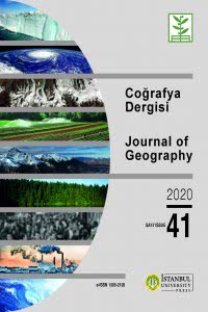Türkiye’nin Sıcak ve Soğuk Ekstremlerindeki Uzun Süreli Değişimler
Ekstrem sıcak havalar, dünyanın her yerindeki hava koşullarına bağlı afetlerin önde başta gelen nedenidir. Soğuk ya da sıcak havanın tetikleyici etkisiyle birçok insan her yıl hayatını kaybetmektedir. Aşırı günler genellikle, anormal derecede soğuk veya sıcak hava koşullarının olduğu birkaç günlük bir süre olarak tanımlanır. Bu günlerin frekansındaki artış, ölüme ve afetlere yol açabilmektedir.
Long-Term Changes in Hot and Cold Extremes in Turkey
Extreme weathers are the leading cause of weather-related disasters all over the world. Many people lose their lives each year due to the triggering effect of cold or hot weather. The extreme days are generally defined as a period of several days of abnormally cold or hot weather. Increased frequency of these days could lead to death and disasters.
Keywords:
Turkey, Extremes, Cluster Analysis,
___
- Acar Deniz, Z., & Gönençgil, B. (2015). Trends of summer daily maximum temperature extremes in Turkey. Physical Geography, 36(4), 268–281.
- Barbosa, S. M., Scotto, M. G., & Alonso, A. M. (2011). Summarising changes in air temperature over Central Europe by quantile regression and clustering. Natural Hazards and Earth System Sciences, 11, 3227–3233.
- Beniston, M., Stephenson, D.B., Christensen, O.B., Ferro, C.A.T., Frei, C., Goyette, S., ... Woth, K. (2007). Future extreme events in European climate: an exploration of regional climate model projections. Climatic Change 81 (Supp. 1), 71-95. https://dx.doi.org/10.1007/s10584-006-9226-z
- Bindoff, N.L., P.A. Stott, K.M. AchutaRao, M.R. Allen, N. Gillett, D. Gutzler, … X. Zhang. (2013). Detection and attribution of climate change: from global to regional. In Climate change 2013: The physical science basis. Contribution of working group I to the fifth assessment report of the Intergovernmental Panel on Climate Change [Stocker, T.F., D. Qin, G.-K. Plattner, M. Tignor, S.K. Allen, J. Boschung, A. Nauels, Y. Xia, V. Bex and P.M. Midgley (eds.)]. Cambridge, United Kingdom and New York, NY, USA: Cambridge University Press.
- El Kenawy, A. E., Lopez-Moreno, J. I., & Vicente-Serrano, S. M. (2013). Summer temperature extremes in Northeastern Spain: Spatial regionalization and links to atmospheric circulation (1960-2006). Theoretical & Applied Climatology, 113(3–4), 387–405.
- Easterling, D. R., Meehl, G. A., Parmesan, C., Changnon, S. A., Karl, T. R., & Mearns, L. O. (2000). Climate extremes: Observations, modeling, and impacts. Science, 289, 2068–2074.
- Erlat, E., & Türkeş, M. (2015). Türkiye rekor maksimum ve minimum hava sıcaklıklarının frekanslarında 1950-2014 döneminde gözlenen değişmeler ve atmosfer koşullarıyla bağlantıları [Observed changes in the frequencies of record maximum and record minimum air temperatures in Turkey during the period 1950-2014 and their connections with atmospheric conditions]. Ege Coğrafya Dergisi, 24(2), 29–55.
- Feidas, H., Makrogiannis, T., & Bora-Senta, E. (2004). Trend analysis of air temperature time series in Greece and their relationship with circulation using surface and satellite data: 1955-2001. Theorical and Applied Climatology, 79, 185–208.
- Frich, P., Alexander, L. V., Della-Marta, P., Gleason, B., Haylock, M., Klein Tank, A. M. G., & Peterson, T. (2002). Observed coherent changes in climatic extremes during the second half of the twentieth century. Climate Research, 19, 193–212.
- Gönençgil, B., Acar Deniz, Z., & Mestav, B. (2016). Frost and ice days in Turkey. The International Geographical Union 2016, No:2860170.
- Hegerl, G. C., Zwiers, F. W., Stott, P. A., & Kharin, V. V. (2004). Detectability of anthropogenic changes in annual temperature and precipitation extremes. Journal of Climate, 17, 3683–3700.
- Herting, E., Seubert, S., & Jacobeit, J. (2010). Temperature extremes in the Mediterranean area: trends in the past and assessments for the future. Natural Hazards and Earth System Sciences, 10, 2039–2050.
- Intergovernmental Panel on Climate Change. (2014). Climate change 2014: Synthesis report. contribution of working groups I, II and III to the fifth assessment report of the Intergovernmental Panel on Climate Change [Core Writing Team, R.K. Pachauri and L.A. Meyer (eds.)]. Geneva, Switzerland:Author
- Kendall, M.G. (1975). Rank correlation methods. London: Charles Griffin Book Series, Oxford University Press.
- Maheras, P., Patrikas, I., Karakostas, Th., & Anagnostopoulou, Ch. (2000). Automatic classification of circulation types in Greece: Methodology, description, frequency, variability and trend analysis. Theorical and Applied Climatology 67, 205–223.
- Maheras, P., Xoplaki, E., & Kutiel, H. (1999). Wet and dry monthly anomalies across the Mediterranean basin and their relationship with circulation, 1860–1990. Theorical and Applied Climatology, 64, 189–199.
- Mann, H.B. (1945). Non-parametric test against trend. Econometrika, 13, 245-259.
- Ozdamar, K. (2002). Paket programlar ile istatistiksel veri analizi [Statistical data analysis with packet programs]. Eskişehir, Turkey:Kaan Kitabevi.
- Xoplaki, E., Luterbaacter, J., Burkard, R., Patrikas, I., & Maheras, P. (2000). Connection between the large-scale 500 hPa geopotential height fields and precipitation over Greece during wintertime. Climate Research, 14, 129 –146.
- Yayın Aralığı: Yılda 2 Sayı
- Başlangıç: 1985
- Yayıncı: İstanbul Üniversitesi
